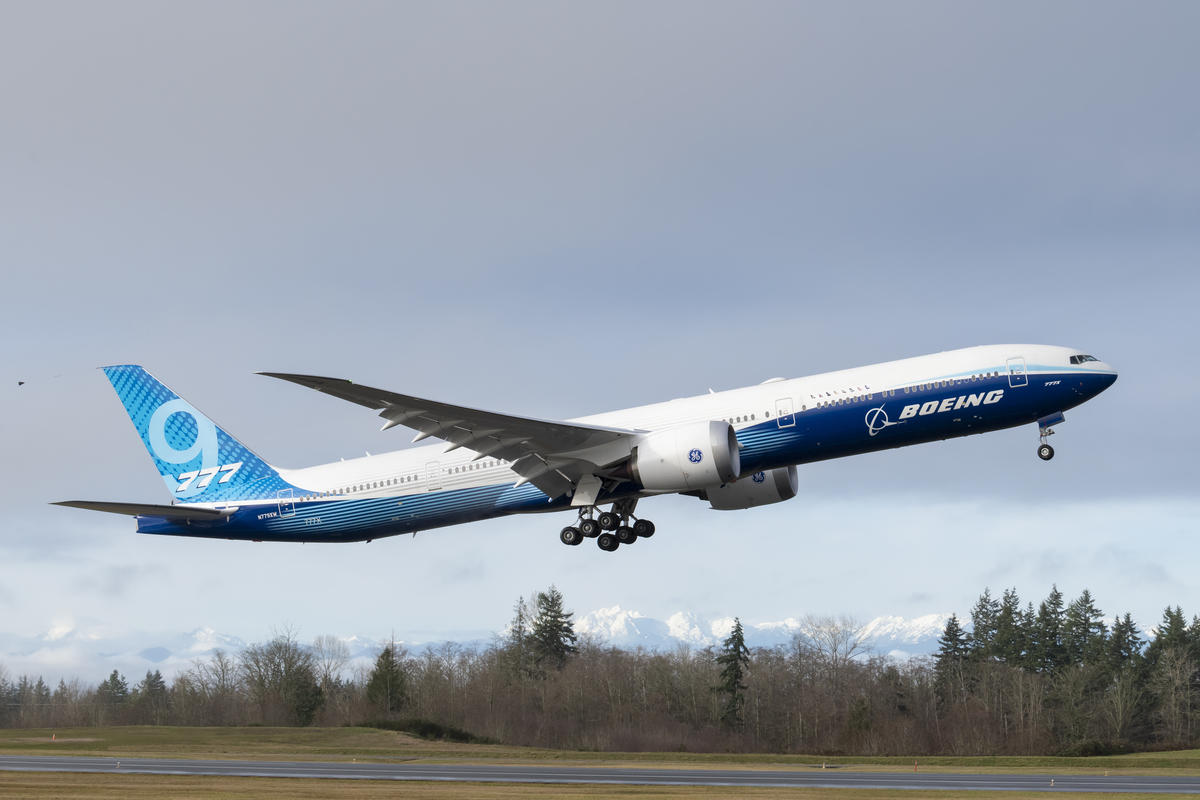

On Saturday, Boeing flew its newest passenger plane for the first time, and after it landed in Seattle, its wingtips did something new to the world of commercial aviation: they folded upwards as the plane was still rolling down the tarmac.
When the new widebody 777x enters service, it will seat as many as 426 people in its longest of two configurations. But while the size of the plane’s fuselage is what allows it to carry so many people, it’s the design of the wings that really sets it apart from an engineering perspective.
In both models of the new aircraft—the 777-8 and the 777-9—the wings will measure 235 feet from tip to folding tip. That’s wider than the wings on existing Boeing 777s or the 787, and about double the wingspan of a 737. With the 777x, Boeing is going to all the trouble to create such a long wing for one simple reason: it allows the plane to be more efficient as it flies. And the company has incorporated the folding, 11-foot-long tips on each wing—and managed the added weight and complexity that comes with such a feature—just to ensure the new airplane can fit at a standard airport gate.
Just like a F/A-18 Super Hornet fighter jet can fold part of its wings to take up less space on an aircraft carrier, the 777x manages its size so that it can politely squeeze into the parking spots at a commercial terminal.
In the air, longer wings create less drag, explains Mark Drela, a professor of aeronautics and astronautics at MIT. “A wing pushes down on the air,” he says. “The longer the wingspan, the more air it can push down on.”
The way the physics work out, a longer wing requires less power to produce the same amount of lift as a shorter wing would need. Drela compares the phenomenon to waterskiing. Imagine a water skier with very narrow skis—the boat would need to use a lot of power to keep them aloft on the water’s surface. The fix is a wider ski. “They’ll have less drag as a result,” he says; the boat can use less power.
A related phenomenon is that the long wings will also produce weaker vortices—rotating air that can form at the wingtips as a result of the wing pushing against it.
But nothing comes for free in aviation: a longer wing weighs more than a shorter one, which explains why airplane makers like Boeing didn’t give its 777 airplanes 235-foot-long wings in the first place. Modern composite materials weigh less, allowing longer wings that are considerably lighter than they would be if they were made out of aluminum. “A composite wing is inherently lighter, therefore its weight overhead is lower,” Drela says, so the wing can be longer. (The mechanisms that allow the tips to fold add weight, but evidently the efficiency math works out in favor of a long, folding wing as opposed to a shorter, more traditional one.)

Two giant General Electric engines—the biggest commercial thrusters the company has ever made—will speed the 777x through the air. The large, 11-foot-wide GE9X engines are more efficient because a bigger engine can manipulate more air. “A wing pushes the air down, whereas the engine pushes the air back—but in both cases you want to influence as much air as possible,” Drela says. (The engines are each about the same diameter as the fuselage of a 737.)
Just like a longer wing is heavier, so too is a bigger engine, so GE needed to mitigate that. One way they accomplished that is by using composite materials, and another is by designing it with fewer spinning fan blades than other engines: the GE engines on the Boeing Dreamliner rely on 18 blades, the engines on existing 777s contain 22, but the new engines employ just 16.
All of these design changes add up to a 10 percent better fuel efficiency, Boeing claims.
Saturday’s 777x sortie lasted nearly 4 hours over Washington state and included a trip around Mt. Rainier. (And if you look at photos or video from the flight, you’ll see an object streaming behind its tail: that’s a hose and sensor that measures the aircraft’s airspeed; Boeing can compare the data it produces with the cockpit’s display.) The troubled airplane maker plans more test flights, and may hand over new 777x planes to carriers such as British Airways and Singapore Airlines as soon as next year.